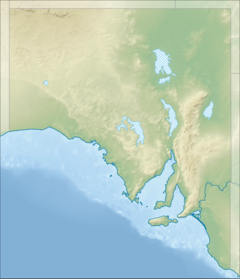This article needs additional citations for verification .(November 2016) |
| Eyre | |
|---|---|
Location of the river mouth in South Australia | |
| Etymology | Edward John Eyre |
| Location | |
| Country | Australia |
| State | South Australia |
| Region | Mid North |
| Physical characteristics | |
| Source | |
| • location | near Mount Horrocks |
| Mouth | confluence with the Wakefield River |
• location | Auburn |
• coordinates | 34°01′05″S138°41′10″E / 34.018040°S 138.686110°E |
| [1] | |
The Eyre Creek is an ephemeral watercourse in the Mid North region of the Australian state of South Australia.
